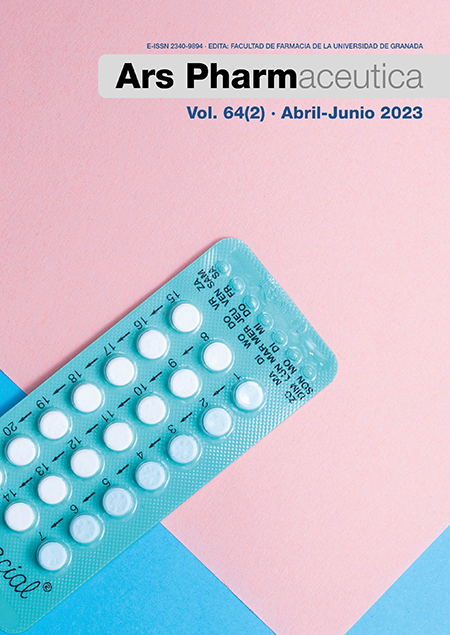Antagonistic effect of mepyramine and tubocurarine on the histamine-mediated contraction of intestinal smooth muscle cells
DOI:
https://doi.org/10.30827/ars.v64i2.27401Keywords:
Histamine, mepyramine, tubocurarine, irritable bowel syndromeAbstract
Introduction: Histamine is an endogenous ligand which exerts its biological actions by binding to 4 subtypes of histamine receptors (HR). Its effects on the gastrointestinal tract are complex being the dominant effect contraction of muscle cells.
Method: The aim of this study was to verify the antagonistic effect of mepyramine (10-10M - 10-7M) and tubocurarine (10-7M - 10-4M) in the contractile action of histamine (10-11M - 10-4M). in guinea pig ileum, for this purpose it was used the program Virtual Organ Bath 16 V 2.8, which allow quantify the change in strength(g) produced by smooth muscle contraction in the presence of these substances. Concentration-response curves were obtained through GraphPad Prism® graphic program. The determination of the competitive nature of the antagonist and the calculation of the affinity constant was performed through Schild method.
Results: Mepyramine is a competitive antagonist of histamine (10-10M to 10-7M), making it a potential therapeutic agent for the treatment of irritable bowel syndrome. On the other hand, it is not understood that tubocurarine is an antagonist of histamine receptors.
Conclusions: The results obtained provide evidence that the contractile effect of histamine on the smooth muscle of intestinal cells isolated from guinea pig is competitively antagonized by mepyramine. In addition, by calculating the pKB parameter, it was found that this compound has greater potency than other antihistamines.
Downloads
References
Fabisiak A, Wlodarczyk J, Fabisiak N, Storr M, Fichna J. Targeting histamine receptors in irritable bowel syndrome: A critical appraisal. Journal of Neurogastroenterology and Motility. 2017; 23(3):341–8. Doi: 10.5056/jnm16203.
Goodman Louis. Goodman and Gilman’s the pharmacological basis of therapeutics. New York: McGraw-Hill;1996.
Izzo A, Costa M, Mascolo N, Capasso F. The role of histamine H1, H2 and H3 receptors on enteric ascending synaptic transmission in the guinea pig ileum. J Pharmacol Exp Ther. 1998;287(3):952-7. PMID: 9864278.
Bertaccini G, Morini G, Coruzzi G. Different mechanisms are responsible for the contractile effects of histaminergic compounds on isolated intestinal smooth muscle cells. J Physiol Paris. 1997;91(3-5):199-202. Doi: 10.1016/s0928-4257(97)89484-3.
Chazot P, Cowart M, Fukui H, Ganellin CR, Gutzmer R, Haas HL et al. Histamine receptors in the IUPHAR/BPS Guide to Pharmacology Database. IUPHAR/BPS Guide to Pharmacology CITE. 2019; 2019(3). Doi: 10.2218/gtopdb/F33/2021.3.
Serna H, Porras M, Vergara P. Mast cell stabilizer ketotifen [4-(1-methyl-4-piperidylidene)-4h-benzo[4,5]cyclohepta[1,2-b]thiophen-10(9h)-one fumarate] prevents mucosal mast cell hyperplasia and intestinal dysmotility in experimental Trichinella spiralis inflammation in the rat. Journal of Pharmacology and Experimental Therapeutics. 2006; 319(3):1104–11. Doi: Doi:10.1124/jpet.106.104620
Smolinska S, Jutel M, Crameri R, O’Mahony L. Histamine and gut mucosal immune regulation. Allergy. 2014;69(3):273-81. Doi: 10.1111/all.12330.
Harvey R, Champe P. Pharmacology (4° ed.). Balitmores: Lippincott Williams y Wilkins; 2009.
Aniszewski T. Alkaloids: chemistry, biology, ecology, and applications. Elsevier; 2015.
Hattori Y, Endou M, Gando S, Kanno M. Identification and characterization of histamine H1- and H2-receptors in guinea-pig left atrial membranes by [3H]-mepyramine and [3H]-tiotidine binding. Br J Pharmacol. 1991;103(2):1573–9. Doi: 10.1111/j.1476-5381.1991.tb09829.x.
Arunlakshana O, Schild H. Some quantitative uses of drug antagonists. Br J Pharmacol.1993;14(1): 48-58. Doi:10.1111/j.1476-5381.1959.tb00928.x.
Treuren B, Galletly D, Robinson B,Short T, Ure R. The influence of the H1 and H2 receptor antagonists, terfenadine and ranitidine on the hypotensive and gastric pH effects of the histamine releasing drugs, morphine and tubocurarine). Anaesthesia. 1993; 48(9):758-62. Doi:10.1111/j.1365-2044.1993.tb07584.x.
Published
How to Cite
Issue
Section
License
Copyright (c) 2023 Andree Salvatierra Baldeón

This work is licensed under a Creative Commons Attribution-NonCommercial-ShareAlike 4.0 International License.
The articles, which are published in this journal, are subject to the following terms in relation to the rights of patrimonial or exploitation:
- The authors will keep their copyright and guarantee to the journal the right of first publication of their work, which will be distributed with a Creative Commons BY-NC-SA 4.0 license that allows third parties to reuse the work whenever its author, quote the original source and do not make commercial use of it.
b. The authors may adopt other non-exclusive licensing agreements for the distribution of the published version of the work (e.g., deposit it in an institutional telematic file or publish it in a monographic volume) provided that the original source of its publication is indicated.
c. Authors are allowed and advised to disseminate their work through the Internet (e.g. in institutional repositories or on their website) before and during the submission process, which can produce interesting exchanges and increase citations of the published work. (See The effect of open access).























